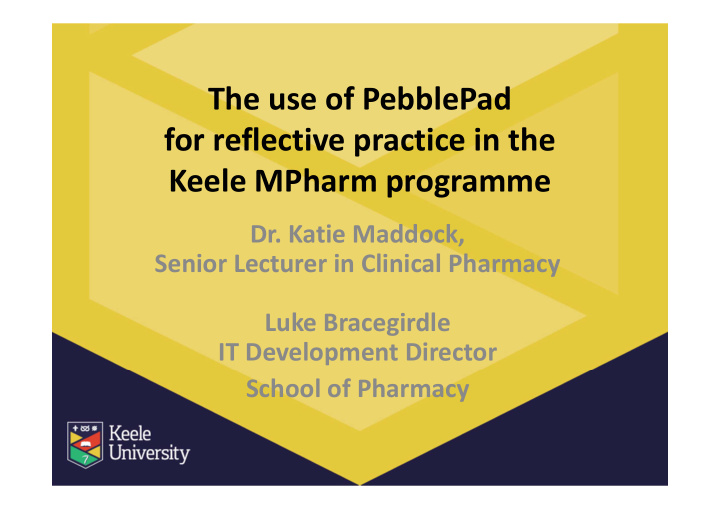



The use of PebblePad for reflective practice in the Keele MPharm programme Dr. Katie Maddock, Senior Lecturer in Clinical Pharmacy Luke Bracegirdle IT Development Director School of Pharmacy
Objectives (PLAN) • To provide students with the facility to contribute to their portfolio at home, in class, on placement etc. • To allow a group of pharmacists to act as mentors • To address specific accreditation requirements from GPhC • To encourage lifelong learning providing an introduction to GPhC CPD for qualified pharmacists
Why Portfolios? • Reflection and personal development are inextricably linked – QAA guidelines on HR Progress Files (Dearing Report 1997) – Moon (2001) – “A form of mental processing…” • Production of a professional portfolio is a requirement for every qualified pharmacist – GPhC require 9 CPD records annually
Why PebblePad? • Students were able to record experiences and reflect anytime / any place / m any device s • Seamless integration with our Learning Management System existed (BlackBoard) was possible • It offered tools to allow students to receive feedback from a network of mentors in the School • Students were able personalise their ‘space’, whilst mentors were able to ‘push’ information to construct a students portfolio.
Who were the stakeholders? (EXPERIENCE) • 360 Undergraduate students • 20 Mentors based across the School • 1 Experiential Learning Manager • Technical staff to liaise with Students, Central IT and Mentors
Feed ‐ forward not just feedback! Features within PebblePad supported the aims to: • Pro ‐ actively guide students to construct reflection in line with course themes and GPhC standards • Allowed dialogue between mentor and student before during and after the Plan ‐ Experience ‐ Observe ‐ Reflect cycle ‐ Kolb’s Learning Cycle (1984) • Students used their own reflections to construct thinking for future events
How was it implemented? • Students provided with templates to construct mandatory pieces of work at each level of study – Levels 1 & 2: Reflective Pieces & Profile Statements – Level 3: SWOT analysis, two Action Plans & Profile Statements – Level 4: 7 Full CPD Cycles (based on GPhC template) & Profile Statements • Ongoing technical support via email/phone (for students & mentors) • Integration with Learning Management System via single sign ‐ on
Results (OBSERVE) • A very flexible platform allowing a variety of uses to feed ‐ forward as well as feedback • Templates can be custom ‐ made to allow structured PDP and CPD to be recorded, linked to professional aims • Students can reflect on progress over a period of time, gathering assets to construct future learning • Integration with the Learning Management System for seamless transition
Reflections (REFLECT) • Pebblepad was a flexible solution, providing many tools to encourage reflection and construct reflection. • Many students wished to attached ‘artefacts’ of evidence (e.g. scanned prescriptions) which our templates can be designed better to encourage. • PebblePad+ offers user interface enhancements to enhance our template design and student experience • Integration for single sign ‐ on was well received, but greater integration was possible with the use of the Blackboard Building Block.
Contact Details • Dr. Katie Maddock Senior Lecturer in Clinical Pharmacy k.maddock@mema.keele.ac.uk • Luke Bracegirdle IT Development Director l.bracegirdle@mema.keele.ac.uk
Recommend
More recommend